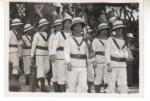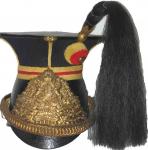-
Posts
1,761 -
Joined
-
Last visited
-
Days Won
3
Content Type
Profiles
Forums
Blogs
Gallery
Events
Store
Everything posted by Stuart Bates
-

Unit ID from helmet flash
Stuart Bates replied to Tony's topic in Great Britain: Militaria: Badges, Uniforms & Equipment
East Surrey regiment. Stuart -

General Officer Wollesley?
Stuart Bates replied to TS Allen's topic in Great Britain: Militaria: Badges, Uniforms & Equipment
I couldn't view the picture, probably been removed by now, but I have never seen a Wolseley with a bullion badge. I have over 30 Ws in my collection and have seen many, many more. The Dress Regulations state that no badges are to be worn on the khaki Wolseley but they were. I wouldn't touch this one with the proverbial barge pole. Stuart -
Hi Jeff, I am afraid that it is not a Wolseley helmet. I have heard it called the "Standard Pattern" but do not have any corroborating evidence. It does look like the style worn by sailors in the 1920s and '30s. It is similar to the civilian Shikari helmet which was used a lot in hunting. British officers probably used it when off duty to preserve their expensive Wolseleys. Here is a photo of sailors from HMS Tarantula in Canton in 1937. Note the similarity of the helmet to theirs. Stuart
-

The South African Mounted Rifles (SAMR)
Stuart Bates replied to sabrigade's topic in Police Forces of the World
Will, thanks for the interior shots. It is a fairly standard Wolseley intrinsically, but a lovely example. What is attached to the side, as I see two sets of bent shanks/tabs/prongs on the left hand side. Are they securing a flash or another badge? E.W. Vero was one of the larger helmet manufacturers and patented a detachable headband in 1925, and I note that yours bears their label dated to 1921. It is in superb condition. A forlorn hope but if you ever want to sell... Do start a thread on SA (and Rhodesian) bush hats. Thanks again, Stuart PS. there is already a thread on the Wolseley helmet -
I allocated the 16th Light Dragoons at Waterloo for research, but when I started I unearthed some lovely information about and additional photos of the Wolseley helmet. That takes priority as I want to get the book to the printers at least by September. But I will get back to the 16th soonish. As you say it's more than just posting a few photos. Although I see my original 16th Lancers is back! Must be a problem with Photobucket, yes? Stuart
-
Hi Mervyn, the swan is painted. Pity as an enamel one would have been so much better. I guess the chinchain would have had many extra loops at the end to allow it to be hooked up. One of the nicer aspects of this helmet is that it came from a dealer's private collection. That makes two so far, the other being my 1913 Australian Engineers Wolseley from the same dealer. Stuart
-

The South African Mounted Rifles (SAMR)
Stuart Bates replied to sabrigade's topic in Police Forces of the World
Dear Will, getting me a copy of Hamish's article is very kind of you. I was going to say "uncommonly kind" but it's not on this forum. I am finishing off the Wolseley book, but I keep saying that, and then some more information comes to light. Never thought a single helmet could generate a book of 100+ pages but I hope to go to the printers late September. I hope you remain a pith helmet collector at least until then:D Stuart PS. is the smiley displaying as when I post the reply I get :D -

The South African Mounted Rifles (SAMR)
Stuart Bates replied to sabrigade's topic in Police Forces of the World
Will, thanks for the information. I shall attempt to locate a copy of the article you mention. Please start a thread on SA bush helmets, I am a helmet collector after all:D -

The South African Mounted Rifles (SAMR)
Stuart Bates replied to sabrigade's topic in Police Forces of the World
Chris, this looks more like a Wolseley than a polo helmet. Wolseleys could vary considerably in the early days of hand production because of variations in hat blocks and the skill of the hatter. Stuart -

The South African Mounted Rifles (SAMR)
Stuart Bates replied to sabrigade's topic in Police Forces of the World
Hi Will, I wondered if you got a copy of the book. Do you know when the Polo helmet was officially adopted by the SA forces and why did they choose that style over the Wolseley. The Kimberley and Witwatersrand Regiments wore the polo style but from a Player's cigarette card I have Regiment Louw Wepener seems to have opted for the Wolseley. Regards, Stuart -

The South African Mounted Rifles (SAMR)
Stuart Bates replied to sabrigade's topic in Police Forces of the World
Any chance of an interior shot of the Wolseley? Stuart -
Having done some more checking the 9th, 12th and 16th all have battle honours from the Peninsular Campaign and Waterloo. This makes sense as honours awarded when they were Light Dragoons would not have been dropped on conversion to Lancers. It would have caused a mutiny The 19th and the 23rd were in Lower Canada in 1815 and various stations in India, Ireland and England during the Peninsular Campaign. Stuart
-
I forgot to add that the 16th have battle honours for the Peninsular Campaign and Waterloo even though my information clearly states that they were converted from Light Dragoons in 1816. Now there is an area for research! Here is my 16th Lancers Officer's lance cap clearly showing the battle honours mentioned above (just joking). I don't know why Photobucket corrupted the photo so will try again.
-
According to David J.J. Rowe, Major John Floyd of the 21st Light Dragoons acquired a few lances in 1780 and made his men practise with them. However, his enthusiasm apparently led nowhere. Rowe also states that in 1793 the British employed foreign lancers (Polish), who formed the Uhlans Britaniques and served in the Flanders Campaign. They were disbanded in 1798. In 1816 the following Light Dragoon Regiments were converted to Lancers 9th, 12th, 16th, 19th and 23rd, although the 19th was disbanded in 1821 and the 23rd in 1817. However, the 3 remaining Lancer Regiments were joined by the 17th in 1822 and the reformed 5th (or Royal Irish) Regiment of Dragoons in 1858. It is noteworthy that these regiments were designated as Light Dragoons (Lancers) until 1861 when the appellation Light Dragoons was dropped. The last Lancer Regiment was formed when the 21st Hussars converted in 1897 and made the famous cavalry charge at Omdurman in 1898 suffering casualties of 21 killed and 50 wounded. That should start the ball rolling Mervyn but here is a Busby to the 21st before they converted. Stuart Why do attachments display so large? How does one make them a reasonable size?
-
My reading indicates that the Heavy Cavalry charged to save the day for Picton's Division which was being roughly handled by D'Erlon's infantry and the French Cavalry but they also disabled 15 guns of a French Battery which had done so much damage to the Allied troops. The Heavy Cavalry charge was composed of 2 Brigades; the Union and the Household - Union Brigade - The Royals - 89 killed and 107 wounded 2nd North British Dragoons - 99 killed and 97 wounded. In 1866 2nd (Royal North British) Dragoons (Royal Scots Greys) and in 1877 2nd Dragoons (Royal Scots Greys) 6th (Inniskilling) Regiment of Dragoons - 73 killed and 116 wounded Household Brigade - 1st Life Guards - 18 killed and 42 wounded 2nd Life Guards - 17 killed and 40 wounded Royal Horse Guards - 17 killed and 60 wounded King's Dragoon Guards - 43 killed and 104 wounded Ok better get on with Lancers.







